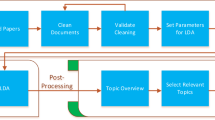Abstract
Users of web sites often do not know exactly which information they are looking for nor what the site has to offer. The purpose of their interaction is not only to fulfill but also to articulate their information needs. In these cases users need to pass through a series of pages before they can use the information that will eventually answer their questions. Current systems that support navigation predict which pages are interesting for the users on the basis of commonalities in the contents or the usage of the pages. They do not take into account the order in which the pages must be visited. In this paper we propose a method to automatically divide the pages of a web site on the basis of user logs into sets of pages that correspond to navigation stages. The method searches for an optimal number of stages and assigns each page to a stage. The stages can be used in combination with the pages’ topics to give better recommendations or to structure or adapt the site. The resulting navigation structures guide the users step by step through the site providing pages that do not only match the topic of the user’s search, but also the current stage of the navigation process.
Similar content being viewed by others
References
Alpay L.L., Toussaint P.J., Ezendam N.P.M., Rövekamp A.J.M., Graafmans W.C., Westendorp R.G.J. (2004) Easing internet access of health information for elderly users. Health Informatics J. 10(3): 185–194
Alpay, L.L., Ezendam, N.P.M., Zwetsloot-Schonk, J.H.M.: Final report of the Geriwijzer/Senior Gezond project.Technical Report, Leiden University Medical Center, Leiden, The Netherlands (2005)
Anderson, C.R., Domingos, P., Weld, D.S.: Adaptive web navigation for wireless devices. Proceedings of the Seventeenth International Joint Conference on Artificial Intelligence, pp. 879–884. Seattle, Washington, USA (2001)
Anderson, C.R., Horvitz, E.: Web montage: a dynamic personalized start page. Proceedings of the 11th International Conference on World Wide Web, pp. 704–712. Honolulu, Hawaii, USA (2000)
De Bra P., Calvi L. (1998) AHA! an open adaptive hypermedia architecture. New Rev Hypermedia 4, 115–139
Brusilovsky P. (2001) Adaptive hypermedia. User Model. User-Adapt. 11(1–2): 87–110
Brusilovsky, P., Eklund, J., Schwarz, E.: Web-based education for all: a tool for developing adaptive courseware. Proceedings of the Seventh International World Wide Web Conference, pp. 291–300. Brisbane, Australia (1998)
Cadez I., Heckerman D., Meek C., Smyth P., White S. (2003) Model-based clustering and visualization of navigation patterns on a web site. Data Mining Knowledge Discovery 7(4): 399–424
Carroll J.D. (1972) Individual differences and multidimensional scaling. Multidimensional Scaling: Theory Appl. Behav. Scio. 1, 105–155
Choo, C., Detlor, B., Turnbull, D.: working the web: an empirical model of web use. Proceedings of the 33rd Hawaii International Conference on System Sciences. Maui, Hawaii (2000)
Clancey W. (1985) Heuristic classification. Artif. Intell. 27(3): 289–350
Cooley R., Mobasher B., Srivastava J. (1999) Data preparation for mining world wide web browsing patterns. J. Knowledge Inform. Syst. 1(1): 5–32
Deshpande M., Karypis G. (2004) Selective Markov models for predicting web page accesses. ACM Trans. Internet Technol. 4(2): 163–184
Dempster A., Laird N., Rubin D. (1977) Maximum likelihood from incomplete data via the EM algorithm. J. Roy. Stat. Soc. 39, 1–38
Domshlak, C., Joachims, T.: Efficient and non-parametric reasoning over user preferences. This issue.
Ezendam, N.P.M., Alpay, L.L., Rövekamp, A.J.M., Toussaint, PJ.: Enhancing accessibility of the content of a fall prevention website for elderly: a cross sectional study. Technical Report, Leiden University Medical Center, Leiden, The Netherlands (2005)
Herder, E.: Sniffing around for providing navigation assistance. Proceedings of the Workshop on Adaptivity and User Modeling in Interactive Systems, pp. 20–24. Berlin, Germany (2004)
Hollink, V., van Someren, M., ten Hagen, S.: Discovering stages in web navigation. Proceedings of the 10th International Conference on User Modeling, pp. 473–482. Edinburgh, UK (2005a)
Hollink, V., van Someren, M., ten Hagen, S., Wielinga, B.: Recommending informative links. Proceedings of the IJCAI-05 Workshop on Intelligent Techniques for Web Personalization, pp. 65–72. Edinburgh, UK (2005b)
Jin, X., Zhou, Y., Mobasher, B.: Task-oriented web user modeling for recommendation’. Proceedings of the 10th International Conference on User Modeling, pp. 109–118. Edinburgh, UK (2005)
Mobasher B., Dai H., Luo T., Nakagawa M. (2002) Discovery and evaluation of aggregate usage profiles for web personalization. Data Mining Knowledge Discovery 6, 61–82
Perkowitz M., Etzioni O. (2000) Towards adaptive web sites: conceptual framework and case study. Intell. 118, 245–275
Pierrakos, D., Paliouras, G.: Exploiting probabilistic latent information for the construction of community web directories. Proceedings of the 10th International Conference on User Modeling, pp. 89–98. Edinburgh, UK. (2005)
Pierrakos D., Paliouras G., Papatheodorou C., Spyropoulos C. D. (2003) Web usage mining as a tool for personalization: A survey. User Model. User-Adapt. 13(4): 311–372
Pirolli, P., Fu, W.-T.: SNIF-ACT: a model of information foraging on the world wide web. Ninth International Conference on User Modeling, pp 45–54. Johnstown, USA (2003)
Pitkow, J.E., Pirolli, P.: Mining longest repeated subsequences to predict world wide web surfing. Proceedings of the Second USENIX Symposium on Internet Technologies and Systems, Boulder, USA (1999)
Sarukkai, R.: Link prediction and path analysis using markov chains. Proceedings of the Ninth International World Wide Web Conference, pp. 377–386. Amsterdam, The Netherlands (2000)
Schwab, I., Pohl, W.: Learning user profiles from positive examples. Proceedings of the ACAI’99 Workshop on Machine Learning in User Modeling, pp. 15–20. Chania, Greece (1999)
Ypma A., Heskes T. (2003) Automatic categorization of web pages and user clustering with mixtures of hidden markov models. Lecture Notes in Computer Science 2703, 35–49
Zhu, T., Greiner, R., Häubl, G.: Learning a model of a web user’s interests. Proceedings of the Ninth International Conference on User Modeling, pp. 65–75. Johnstown, USA (2003)
Author information
Authors and Affiliations
Corresponding author
Rights and permissions
About this article
Cite this article
Hollink, V., van Someren, M. & Wielinga, B.J. Discovering stages in web navigation for problem-oriented navigation support. User Model User-Adap Inter 17, 183–214 (2007). https://doi.org/10.1007/s11257-006-9017-2
Received:
Accepted:
Published:
Issue Date:
DOI: https://doi.org/10.1007/s11257-006-9017-2




